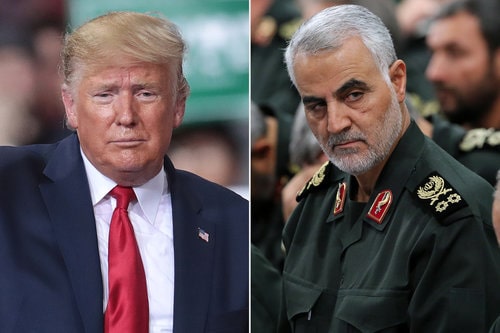Gen. Qassem Soleimani was a shadowy figure in command of Iran’s proxy forces, responsible for the deaths of thousands and thousands of American troops in Iraq.
On Friday, President Donald Trump killed him and some of his top commanders in the region.
BREAKING: Viagra Obsolete: New Invention Cheaper, Safer, Faster
Relatively unknown in Iran until the 2003 U.S. invasion of Iraq, Soleimani’s popularity and mystique grew after American officials first called for his killing.
A decade and a half later, Soleimani had become Iran’s most recognizable battlefield commander, ignoring calls to enter politics but becoming as powerful, if not more, than its civilian leadership.
“The warfront is mankind’s lost paradise,” Soleimani recounted in a 2009 interview. “One type of paradise that is portrayed for mankind is streams, beautiful nymphs and greeneries. But there is another kind of paradise. … The warfront was the lost paradise of the human beings, indeed.”
A U.S. airstrike killed Soleimani, 62, and other anti-American militia leaders as they traveled from Baghdad’s international airport early Friday morning. The Pentagon said Trump ordered the U.S. military to take “decisive defensive action to protect U.S. personnel abroad by killing” a man once referred to by Iran’s Supreme Leader Ayatollah Ali Khamenei as a “living martyr of the revolution.”
Soleimani’s luck ran out after being rumored dead several times in his life. Those incidents included a 2006 airplane crash that killed other military officials in northwestern Iran and a 2012 bombing in Damascus that killed top aides of Syrian dictator and Russian puppet Bashar al-Assad.
More recently, rumors circulated in November 2015 that Soleimani was killed or seriously wounded leading forces loyal to Assad as they fought around Syria’s Aleppo.
Iranian officials quickly vowed to take revenge amid months of tensions between Iran and the U.S. following Trump pulling out of Tehran’s nuclear deal with world powers. While Soleimani was the Guard’s most prominent general, many others in its ranks have experience in waging the asymmetrical, proxy attacks for which Iran has become known.
Born March 11, 1957, Soleimani was to have grown up near the mountainous and the historic Iranian town of Rabor. The U.S. State Department has said he was born in the Iranian religious capital of Qom.
By the time he was 13, Soleimani began working in construction, later as an employee of the Kerman Water Organization. Iran’s 1979 Islamic Revolution swept the shah from power and Soleimani joined the Revolutionary Guard in its wake. He deployed to Iran’s northwest with forces that brutally put down Kurdish unrest following the revolution.
Soon after, Iraq invaded Iran and began the two countries long, bloody eight-year war. The fighting killed more than 1 million people and saw Iran send waves of lightly armed troops into minefields and the fire of Iraqi forces, including teenage soldiers. Solemani’s unit and others came under attack by Iraqi chemical weapons as well.
Amid the carnage, Soleimani became known for his opposition to “meaningless deaths” on the battlefield, while still weeping at times with fervor when exhorting his men into combat, embracing each individually.
After the Iraq-Iran war, Soleimani largely disappeared from public view for several years, something analysts attribute to his wartime disagreements with Hashemi Rafsanjani, who would serve as Iran’s president from 1989 to 1997. But after Rafsanjani, Soleimani became head of the Quds force. He also grew so close to Khamenei that the Supreme Leader officiated the wedding of the general’s daughter.
As chief of the Quds — or Jerusalem — Force, Solemani oversaw the Guard’s foreign operations and soon would come to the attention of Americans following the 2003 invasion of Iraq and the overthrow of dictator Saddam Hussein.
In secret U.S. diplomatic cables released by WikiLeaks, U.S. officials openly discussed Iraqi efforts to reach out to Soleimani to stop rocket attacks on the highly secured Green Zone in Baghdad in 2009.
Another cable in 2007 outlines then-Iraqi President Jalal Talabani offering a U.S. official a message from Soleimani acknowledging having “hundreds” of agents in the country while pledging, “I swear on the grave of (the late Ayatollah Ruhollah) Khomeini I haven’t authorized a bullet against the U.S.”
U.S. officials at the time dismissed Soleimani’s claim as they saw Iran as both an arsonist and a fireman in Iraq, controlling some Shiite militias while simultaneously stirring dissent and launching attacks.
U.S. forces would blame the Quds Force for an attack in Karbala that killed five American troops, as well as for training and supplying the bomb makers whose improvised explosive devices made IED — improvised explosive device — a dreaded acronym among soldiers.
In a 2010 speech, U.S. Gen. David Petraeus recounted a message from Soleimani he said explained the scope of Iranian’s powers.
“He said, ‘Gen. Petreaus, you should know that I, Qassem Soleimani, control the policy for Iran with respect to Iraq, Lebanon, Gaza and Afghanistan,’” Petraeus said.
The U.S. and the United Nations put Soleimani on sanctions lists in 2007, though his travels continued. In 2011, U.S. officials also named him as a defendant in an outlandish Quds Force plot to allegedly hire a purported Mexican drug cartel assassin to kill a Saudi diplomat.
The attention the West gave Soleimani only boosted his profile at home. He sat at Khamenei’s side at key meetings. He famously met Syria’s Assad in February together with the supreme leader — but without Iran’s Foreign Minister Mohammad Javad Zarif being present, which sparking a momentary resignation by the top Iranian diplomat.
The airstrike on the terror leader comes in the wake of months of provocation from Iran.
Citing threats from Iran, the White House in May ordered a U.S. aircraft carrier to rush to the Persian Gulf. Soon after, explosions from Iranian-laid mines damaged international oil tankers near the crucial Strait of Hormuz, through which 20% of all oil passes.
Iran later seized oil tankers in response to one of its tankers being seized off Gibraltar. Then, Iran also shot down a U.S. military surveillance drone. Trump pulled back from retaliating for the attack.
Meanwhile, attacks on Saudi Arabia’s energy industry escalated to a missile-and-drone strike in September temporarily halving its oil production. Israel meanwhile has repeatedly struck Iran-linked targets in Syria in recent years and has warned against any permanent Iranian presence on the frontier.
The attacks culminated with Iranian-backed missile attacks that killed one American contractor. American airstrikes hit Iranian-backed militias in Iraq in response this week.
TRENDING: This Keeps Your Blood Sugar Below 100 - Even When You're Eating Sweets!
Those militiamen, acting under Solemani’s orders, attempted to storm the U.S. Embassy in Baghdad with the goal of kidnapping or killing U.S. Diplomats.
That’s when Trump ordered the airstrike against Solemani and his commanders, still in the country and organizing further U.S. attacks.








